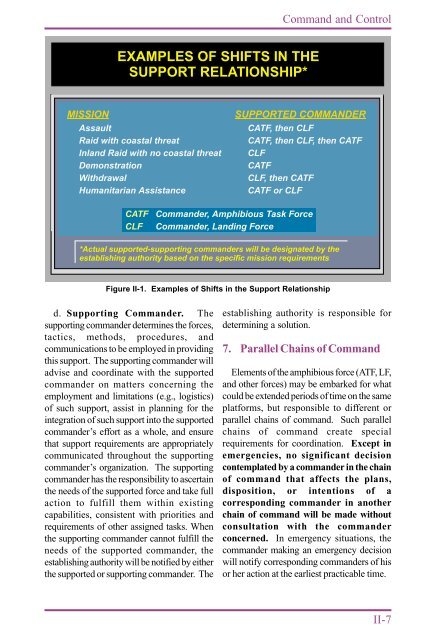Joint Doctrine for Amphibious Operations - Historic Naval Ships ...
Joint Doctrine for Amphibious Operations - Historic Naval Ships ...
Joint Doctrine for Amphibious Operations - Historic Naval Ships ...
- No tags were found...
Create successful ePaper yourself
Turn your PDF publications into a flip-book with our unique Google optimized e-Paper software.
Command and ControlEXAMPLES OF SHIFTS IN THESUPPORT RELATIONSHIP*MISSIONAssaultRaid with coastal threatInland Raid with no coastal threatDemonstrationWithdrawalHumanitarian AssistanceSUPPORTED COMMANDERCATF, then CLFCATF, then CLF, then CATFCLFCATFCLF, then CATFCATF or CLFCATFCLFCommander, <strong>Amphibious</strong> Task ForceCommander, Landing Force*Actual supported-supporting commanders will be designated by theestablishing authority based on the specific mission requirementsFigure II-1. Examples of Shifts in the Support Relationshipd. Supporting Commander. Thesupporting commander determines the <strong>for</strong>ces,tactics, methods, procedures, andcommunications to be employed in providingthis support. The supporting commander willadvise and coordinate with the supportedcommander on matters concerning theemployment and limitations (e.g., logistics)of such support, assist in planning <strong>for</strong> theintegration of such support into the supportedcommander’s ef<strong>for</strong>t as a whole, and ensurethat support requirements are appropriatelycommunicated throughout the supportingcommander’s organization. The supportingcommander has the responsibility to ascertainthe needs of the supported <strong>for</strong>ce and take fullaction to fulfill them within existingcapabilities, consistent with priorities andrequirements of other assigned tasks. Whenthe supporting commander cannot fulfill theneeds of the supported commander, theestablishing authority will be notified by eitherthe supported or supporting commander. Theestablishing authority is responsible <strong>for</strong>determining a solution.7. Parallel Chains of CommandElements of the amphibious <strong>for</strong>ce (ATF, LF,and other <strong>for</strong>ces) may be embarked <strong>for</strong> whatcould be extended periods of time on the sameplat<strong>for</strong>ms, but responsible to different orparallel chains of command. Such parallelchains of command create specialrequirements <strong>for</strong> coordination. Except inemergencies, no significant decisioncontemplated by a commander in the chainof command that affects the plans,disposition, or intentions of acorresponding commander in anotherchain of command will be made withoutconsultation with the commanderconcerned. In emergency situations, thecommander making an emergency decisionwill notify corresponding commanders of hisor her action at the earliest practicable time.II-7
















